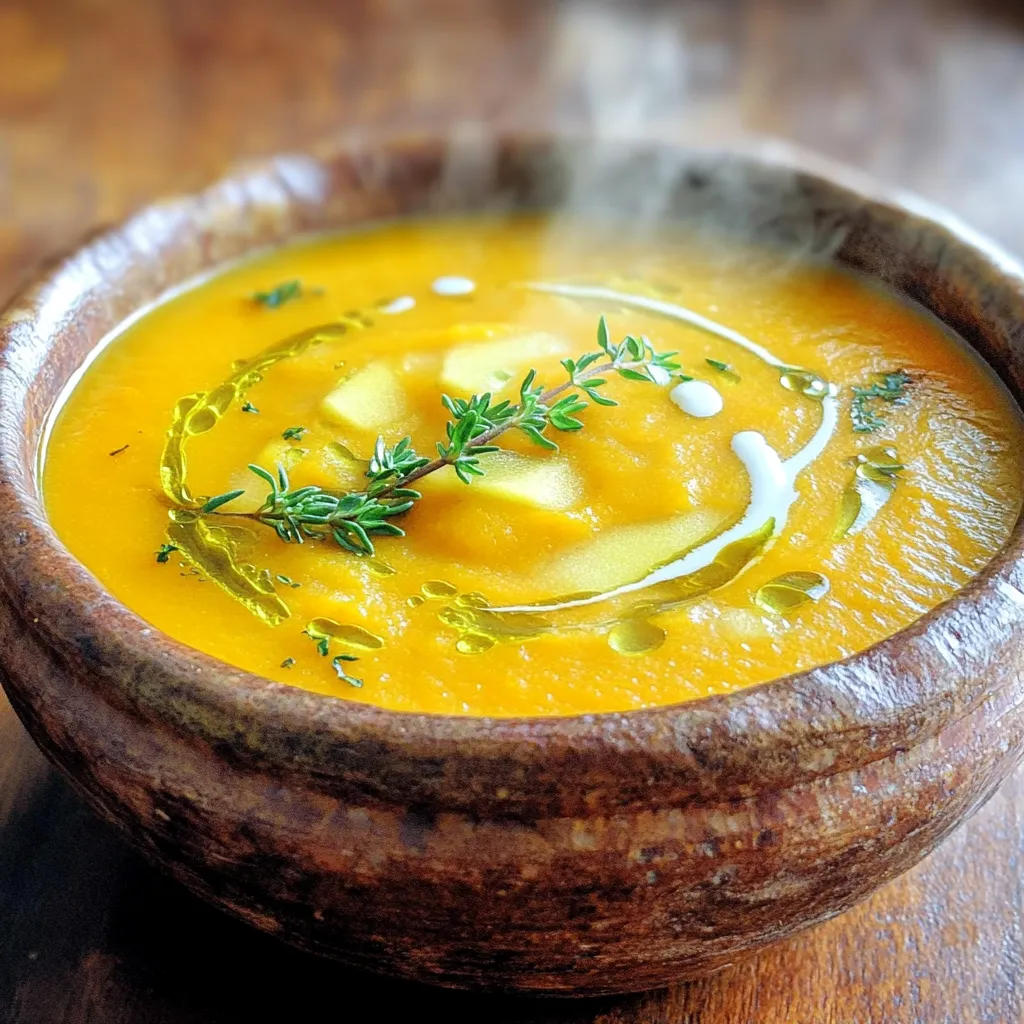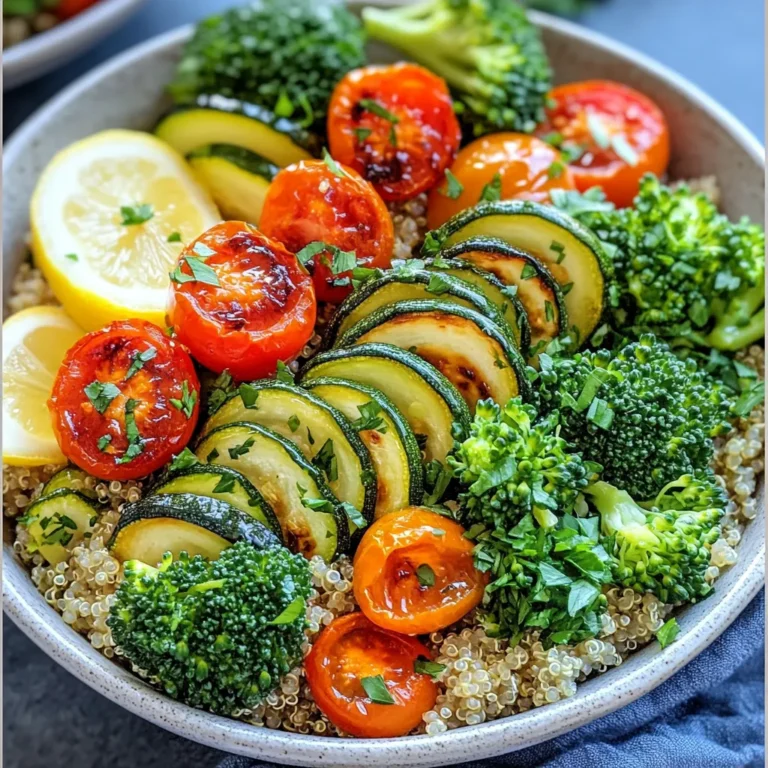Butternut Squash Apple Soup Creamy and Flavorful Treat

Welcome to the warm embrace of fall flavors with my Butternut Squash Apple Soup! This creamy and flavorful treat blends sweet butternut squash with tart apples, creating a cozy dish perfect for chilly days. In this post, I’ll share easy steps, tips, and variations to make this soup your own. Grab your apron, and let’s dive into this delicious recipe that will leave you craving more!
Ingredients
List of Ingredients
– 1 medium butternut squash, peeled and diced into 1-inch cubes
– 2 medium tart apples, such as Granny Smith, cored and diced into small pieces
– 1 medium onion, finely chopped
– 2 cloves garlic, minced or pressed
– 4 cups vegetable broth (low-sodium recommended)
– 1 teaspoon ground ginger
– 1 teaspoon ground cinnamon
– Salt and freshly ground black pepper, to taste
– 2 tablespoons extra virgin olive oil
– 1/2 cup coconut cream (optional for added creaminess)
– Fresh thyme or finely chopped chives for garnish
When I make this soup, I always start with fresh and high-quality ingredients. The butternut squash brings a sweet, nutty flavor. Tart apples like Granny Smith add a nice zing. They balance the sweetness of the squash perfectly.
You need a medium onion and garlic to build a strong flavor base. The broth gives richness, while spices like ginger and cinnamon add warmth. Olive oil helps sauté the onions and garlic to a soft golden color.
If you want extra creaminess, coconut cream is a great choice. It enhances the texture without overpowering the taste. Finally, you can top the soup with fresh thyme or chives. They add a lovely touch and a pop of color.
Gather all these ingredients, and you are ready to create a cozy bowl of butternut squash apple soup!
Step-by-Step Instructions
Preparation Steps
1. Sautéing the onions and garlic
Start by adding olive oil to a large soup pot. Heat it over medium. Add the chopped onion and minced garlic. Stir them often. Cook for about five minutes. You want them soft and clear.
2. Adding butternut squash and apples
Next, toss in the diced butternut squash and apples. Mix them well. Stir frequently for five to seven minutes. This helps soften them and brings out their flavors.
3. Incorporating spices
When the squash and apples soften, add ground ginger and cinnamon. Sprinkle them evenly over the mix. Stir well so all pieces get coated with the warm spices.
Cooking Process
1. Boiling and simmering the soup
Carefully pour in the vegetable broth. Bring the mixture to a gentle boil. Once boiling, reduce the heat to low. Let it simmer uncovered for 20 to 25 minutes. The squash should be tender enough to pierce with a fork.
2. Blending for a smooth texture
After cooking, use an immersion blender to blend the soup. Blend until it is smooth and creamy. If you don’t have an immersion blender, use a standard blender. Blend in batches if needed, then return the soup to the pot.
3. Adding coconut cream (optional)
If you like, stir in coconut cream for extra richness. This makes the soup even creamier. Season it with salt and pepper to taste. Heat gently over low until warm.
Serving Suggestions
1. Ideal serving temperature
Serve the soup hot for the best taste. It warms you up and brings comfort.
2. Presentation tips and garnishing ideas
Use warm bowls for serving. Drizzle a little coconut cream on top. Add fresh thyme or chives for a pop of color. This makes your soup look as good as it tastes.
Tips & Tricks
Tips for Enhancing Flavor
To boost the flavor of your soup, consider adjusting the spices. Adding more ginger will give it a nice kick. If you enjoy warmth, increase the cinnamon for a cozy touch.
When it comes to herbs, fresh thyme or chives work best. They add a bright flavor that dried herbs can’t match. If fresh herbs aren’t available, use dried ones. Just remember, dried herbs are more potent, so use less.
Kitchen Tools
You’ll need a few key tools to make this soup. A large pot is essential for cooking the ingredients. An immersion blender is perfect for blending the soup smooth.
If you don’t have an immersion blender, no problem! Use a standard blender instead. Just let the soup cool a bit first, then blend in batches for safety.
Common Mistakes to Avoid
One common mistake is overcooking the vegetables. Keep an eye on them so they soften but don’t turn mushy. This will help keep the soup’s texture nice.
Another mistake is not balancing the seasoning. Taste your soup before serving. Adjust with salt and pepper to get it just right. A well-seasoned soup can make all the difference!

Variations
Ingredient Substitutions
You can switch out the butternut squash for other squashes. Acorn squash or kabocha squash works well. Sweet potatoes also add a nice twist. Each option gives a different taste and texture.
For the apples, try using a sweeter kind like Fuji or Honeycrisp. These apples will change the soup’s flavor. A mix of apples can bring a fun balance of sweet and tart.
Dietary Adjustments
If you want a vegan soup, just use vegetable broth. This soup is naturally gluten-free, so you don’t need to change much. To make it lower in calories, skip the coconut cream. You can also cut back on olive oil.
For a low-fat version, use less oil and add more broth. This way, you still get a great flavor without extra fat.
Serving Variations
This soup pairs well with warm bread. A crusty baguette or soft rolls can make a nice side. You could also serve it with a fresh salad for a healthy meal.
If you want something different, try chilling the soup. Chilled butternut squash apple soup is refreshing on warm days. Just blend it and let it cool in the fridge before serving.
Storage Info
How to Store Leftovers
To keep your butternut squash apple soup fresh, use airtight containers. Glass or plastic containers work well. Make sure the soup cools first. Store it in the refrigerator for up to four days. If you want to save it longer, freeze it. In the freezer, it can last up to three months.
Label your containers with the date you made the soup. This helps you keep track of freshness. When you are ready to enjoy it again, simply thaw it in the fridge overnight before reheating.
Reheating Tips
When reheating soup, the best method is on the stove. Pour the soup into a pot and heat it over low to medium heat. Stir it often to ensure even heating. If you prefer a microwave, use a microwave-safe bowl. Heat it in short bursts, stirring in between.
To avoid separation issues with the coconut cream, add it in slowly while stirring. This keeps the soup smooth and creamy. If you notice the soup thickening too much, add a splash of broth or water to get the right texture. Enjoy your warm, flavorful soup!
FAQs
What is Butternut Squash Apple Soup?
Butternut squash apple soup is a warm mix of sweet and savory. The squash gives it a creamy base, while tart apples add a light sweetness. You can taste hints of ginger and cinnamon, which bring cozy flavors. The texture is smooth and velvety, creating a comforting bowl of goodness. This soup is perfect for chilly days and makes you feel warm inside.
Can I freeze Butternut Squash Apple Soup?
Yes, you can freeze this soup! To do this, let it cool completely. Next, pour it into an airtight container or freezer bag. Make sure to leave some space at the top for expansion. It can last in the freezer for about three months. When you’re ready to eat, thaw it in the fridge overnight. Reheat gently on the stove for the best taste.
Can I customize the soup for dietary needs?
Absolutely! If you’re vegan, skip the coconut cream or use a plant-based alternative. You can also swap the vegetable broth for homemade broth or water. If you have nut allergies, avoid any nut-based creams. The recipe is flexible, so you can adjust it to fit your needs without losing flavor.
How long does the soup last in the fridge?
In the fridge, this soup stays fresh for about four to five days. Store it in a sealed container to keep it safe. If you notice any changes in smell or color, it’s best to toss it. Reheat only the amount you plan to eat to keep the rest fresh.
This blog covered how to make Butternut Squash Apple Soup from start to finish.
You learned about the key ingredients, cooking steps, and helpful tips. Remember, you can customize this soup to fit your needs. Store leftovers properly for later enjoyment.
This warm dish is not just tasty; it’s also great for your health. Enjoy exploring variations and making it your own. Happy cooking!






![To make garlic Parmesan mashed potatoes, you need a few simple ingredients. Here’s what you will need: - 2 pounds russet potatoes, peeled and cut into 1-inch chunks - 4 cloves garlic, finely minced - ½ cup unsalted butter (1 stick) - 1 cup heavy cream, warmed - 1 cup freshly grated Parmesan cheese - Salt and freshly cracked pepper, to taste - 2 tablespoons fresh parsley, finely chopped (for garnish) - Optional: ½ teaspoon garlic powder for an extra layer of flavor Each ingredient plays a key role in creating that creamy, dreamy texture. Russet potatoes give a fluffy base. The butter brings richness, while the heavy cream adds smoothness. Fresh garlic offers a punch of flavor, and Parmesan gives a salty bite. Don’t forget the salt and pepper; they balance the dish perfectly. For a touch of color and freshness, sprinkle chopped parsley on top. If you want more garlic flavor, add the optional garlic powder. These ingredients come together to create a comfort dish that feels special. For the full recipe, check out the details above! Cooking the Potatoes: Start with two pounds of russet potatoes. Peel them and cut them into one-inch chunks. Place the potatoes in a large pot. Cover them with cold water and add a pinch of salt. Bring the water to a boil over medium-high heat. Once boiling, reduce the heat to medium-low. Let the potatoes simmer for about 15 to 20 minutes, or until they are fork-tender. This is key for creamy mashed potatoes. Creating Garlic Butter: While the potatoes cook, melt half a cup of unsalted butter in a small saucepan over medium heat. After the butter melts, add four cloves of finely minced garlic. Sauté the garlic for one to two minutes. Stir constantly and watch closely to avoid burning. The garlic should be fragrant but not brown. Once ready, remove the saucepan from heat. Mashing Potatoes: After draining the cooked potatoes, return them to the pot. Pour the garlic-infused butter over the potatoes. Add one cup of warmed heavy cream and one cup of freshly grated Parmesan cheese. For texture, you can use a potato masher for a rustic feel or an electric mixer for a smooth finish. Mash until you reach your desired consistency. If you want a chunkier texture, mash for a shorter time. Taste and season with salt and freshly cracked pepper. For extra flavor, consider adding half a teaspoon of garlic powder. Mix it well. Now, you’re ready to enjoy a delightful bowl of garlic Parmesan mashed potatoes. For the full recipe, check out the details above! Tips for Choosing Potatoes: For the best mashed potatoes, I recommend using russet potatoes. They are starchy and fluffy, perfect for mashing. Yukon gold potatoes work too, giving a creamy feel. Avoid waxy potatoes, as they can turn mushy. Warm Liquid Basis: Heating cream and butter is key. Warm liquids blend better, making the potatoes creamy. Cold liquids can cool down the mix, leading to lumpy potatoes. Heat the cream gently, so it’s warm but not boiling. How to Avoid Gluey Mashed Potatoes: To keep your potatoes light, don't over-mash them. Use a potato masher or mixer briefly. Overworking the potatoes releases too much starch, creating a gluey texture. Mix just until smooth, and you'll have fluffy mashed potatoes. For the full recipe, check out the Garlic Bliss Parmesan Mashed Potatoes. {{image_4}} You can easily change the flavor of your garlic Parmesan mashed potatoes. Let’s explore some fun ways to do this. Herb Variations: Adding herbs can make a big difference. You can mix in fresh rosemary or thyme. Just chop a tablespoon of each and stir them into the potatoes. This gives a fresh taste and a nice aroma. Cheese Alternatives: If you want to try something new, swap out the Parmesan cheese. Cheddar works well for a sharper taste. You can also use cream cheese for a richer, creamier texture. Just mix in a cup of your choice until it melts in. Vegan Options: For a vegan version, you can use non-dairy alternatives. Substitute the butter with vegan butter or olive oil. Use almond milk or coconut cream instead of heavy cream. These swaps keep the dish creamy without dairy. Looking for the full recipe? Check out the [Full Recipe] for all the details! To keep your Garlic Parmesan Mashed Potatoes fresh, store them in an airtight container. Place the container in the fridge. They can stay good for about 3 to 5 days. When freezing, ensure the mashed potatoes are cool. Use freezer-safe bags or containers. Squeeze out extra air to prevent freezer burn. They can last up to 2 months in the freezer. To reheat, first, thaw them in the fridge overnight. You can also use the microwave. Add a splash of cream to keep them creamy. Stir well as you heat them to avoid hot spots. For the stove, warm over low heat in a pan. Stir often and add a bit of butter if needed. For more details on making this dish, check the Full Recipe. To make Garlic Parmesan Mashed Potatoes, start with two pounds of russet potatoes. Peel them and cut them into one-inch chunks. Boil the potatoes in salted water until fork-tender, about 15-20 minutes. While cooking, melt half a cup of unsalted butter and sauté four minced garlic cloves until fragrant. Drain the potatoes, then mix in the garlic butter, one cup of warmed heavy cream, and one cup of grated Parmesan cheese. Mash to your desired smoothness, season with salt and pepper, and garnish with chopped parsley. Yes, you can make garlic Parmesan mashed potatoes ahead of time. Prepare them as directed, then cool them down completely. Store in an airtight container in the fridge for up to three days. When you’re ready to serve, reheat them gently on the stove or in the microwave. Add a splash of cream or milk to restore creaminess. Garlic Parmesan mashed potatoes pair perfectly with many dishes. They complement roasted chicken, grilled steak, or baked salmon beautifully. You can also serve them with vegetable dishes, like sautéed green beans or roasted Brussels sprouts. For a comforting meal, add a rich gravy or mushroom sauce on top. Enjoy experimenting with flavors! You can create delicious Garlic Parmesan Mashed Potatoes using simple steps. Start with fresh russet potatoes and add rich garlic and cream. Follow the tips to get the perfect texture and avoid gelatinous mash. Feel free to add herbs or try vegan swaps for fun variations. Don't forget storage tips to ensure your leftovers taste great. Enjoy this creamy dish with your favorite sides and make it your own with unique twists. Embrace the joy of cooking and impress everyone at the table.](https://blissfulmeal.com/wp-content/uploads/2025/07/3c2995e6-5799-40b7-b9d4-7c047cc9890b-768x768.webp)
![- 2 large sweet potatoes, peeled and diced into bite-sized cubes - 1 tablespoon olive oil - 1 teaspoon smoked paprika - Salt and pepper to taste - 1 cup quinoa, thoroughly rinsed under cold water - 2 cups vegetable broth (or water) - 1 cup black beans, rinsed and drained - 1 red bell pepper, diced - 1 cup corn kernels (can be fresh, frozen, or canned) - 1 ripe avocado, diced - 1/4 cup fresh cilantro, finely chopped - Juice of 1 lime - 1 tablespoon honey or agave syrup - Optional: Crumbled feta cheese for a flavorful topping You can change some ingredients if needed. For a lighter option, use less olive oil. Try using lime juice instead of honey for a fresh kick. If you don’t have black beans, chickpeas work well too. Want to skip quinoa? Try using farro or brown rice. For a vegan option, leave out the feta or use vegan cheese. This salad is packed with nutrients. Sweet potatoes give you vitamins A and C, which are great for your skin and eyes. Quinoa adds protein and fiber, helping you feel full longer. Black beans provide more protein and iron, which is important for your blood. Avocado brings healthy fats, which can help keep your heart healthy. This dish is not only tasty but also good for your body. Start by peeling the sweet potatoes. Then, dice them into bite-sized cubes. This helps them cook evenly. Place the diced sweet potatoes in a large bowl. Add olive oil, smoked paprika, salt, and pepper. Toss the cubes well to coat them with the oil and spices. This step adds great flavor to your salad. Now, preheat your oven to 400°F (200°C). Spread the seasoned sweet potatoes on a baking sheet in a single layer. Roast them for 25-30 minutes. Make sure to flip them halfway through. This will help them cook evenly and get that nice golden color. They should be tender when done. While the sweet potatoes roast, it’s time to cook the quinoa. In a medium saucepan, combine the rinsed quinoa and vegetable broth. Bring it to a boil over medium heat. Once boiling, lower the heat to a simmer. Cover the pot and let it cook for about 15 minutes. When the liquid is gone, fluff the quinoa with a fork. It should be light and fluffy, ready to mix into your salad. Follow the [Full Recipe] for a complete guide to making this delicious salad! Start by gathering your ingredients. First, mix the cooked quinoa, black beans, diced red bell pepper, and corn in a large bowl. Next, add the roasted sweet potatoes. Make sure they are still warm for the best flavor. The warm sweet potatoes will blend well with the other ingredients. This mix creates a colorful and tasty base for your salad. In a small bowl, whisk together the lime juice and honey or agave syrup. This dressing is simple but full of flavor. It adds a nice zing to the salad. Taste it to see if you want more sweetness. If you do, add a bit more honey or agave. A good dressing can make all the difference in your dish. Now, pour the dressing over the salad mix. Gently toss everything together so that the dressing coats each piece. Be careful not to mash the avocado when you add it later. After this, fold in the diced avocado and chopped cilantro. These fresh ingredients add a nice touch and brighten the flavors. Finally, taste your salad and adjust the seasoning with salt and pepper if needed. If you want, sprinkle crumbled feta cheese on top for extra flavor. Enjoy your Roasted Sweet Potato Salad, a dish that is both flavorful and nutritious! For the full recipe, check the [Full Recipe]. {{image_4}} When making roasted sweet potato salad, you want flavors that blend well. Here are some great pairings: - Spices: Use smoked paprika for warmth. Cumin adds earthiness, while chili powder gives heat. - Fruits: Apples or oranges can add a touch of sweetness. Dried cranberries also work well. - Nuts and Seeds: Adding pumpkin seeds or walnuts gives a nice crunch. They also add healthy fats. - Cheese: Feta cheese offers a salty contrast. Goat cheese is creamy and tangy, a great choice too. Roasting sweet potatoes is key for flavor. Here are some tips: - Cut Evenly: Dice sweet potatoes into uniform cubes for even cooking. - Use High Heat: Roasting at 400°F (200°C) helps caramelize the sugars. This brings out a deep, rich flavor. - Stir Occasionally: Flip sweet potatoes halfway through roasting. This ensures they brown nicely on all sides. - Cook Quinoa Right: Rinse quinoa well to remove bitterness. Cook it in vegetable broth for added flavor. Making your salad look good is just as fun as eating it. Here are some ideas: - Layering: Start with a base of quinoa. Then, add your roasted sweet potatoes and other veggies on top. - Garnishes: Add fresh cilantro for color. Lime wedges on the side give a fresh look and flavor. - Serving Bowl: Use a large, shallow bowl. This lets each layer show off its colors and textures. - Serving: For a family meal, serve the salad in the center of the table. This invites everyone to dig in. You can easily make this salad vegan. Simply skip the optional feta cheese. The salad stays tasty with the sweet potatoes, quinoa, and black beans. You can add more veggies, like spinach or kale, for extra nutrients. If you want more crunch, try adding nuts or seeds. Sunflower seeds or chopped walnuts work great here. To boost protein, you can add cooked chicken or shrimp. Grilled tofu is another great choice for a plant-based option. You can also use chickpeas or lentils for extra protein and flavor. These additions make the salad more filling. Each option pairs well with the sweet potatoes and dressing. If you want to switch up the dressing, try using tahini or a balsamic vinaigrette. A lemon-herb dressing can also brighten the flavors. Mix olive oil, vinegar, and herbs for a quick homemade option. Each dressing will give a new twist to the salad. Explore different flavors to find your favorite. For the full recipe, check out the details above! To store leftovers, let the salad cool first. Place it in an airtight container. You can keep it in the fridge for up to three days. If you don't want the avocado to brown, add it fresh when serving. This keeps your salad looking bright and fresh. I like to serve this salad chilled or at room temperature. This keeps the flavors bright. For a more appealing look, use a large bowl. Garnish with extra cilantro and lime wedges around the edges. This adds color and a fresh touch. You can also add crumbled feta just before serving for a tasty finish. This salad is perfect for meal prep. You can make it ahead of time for easy lunches. Prep the sweet potatoes and quinoa on the weekend. Store them separately in the fridge. Assemble the salad when you're ready to eat. This keeps everything fresh and tasty. If you want to switch things up, consider adding other veggies or proteins. You can check the Full Recipe for more ideas! Yes, you can make this salad ahead of time. I often prepare it a few hours before serving. Just keep the dressing separate until you are ready to eat. This way, the salad stays fresh and crisp. Store the salad in the fridge in an airtight container. This keeps the flavors bright and the texture nice. If you don't have quinoa, you can use rice or farro. Both options work well in this dish. You can even try couscous or bulgur for a fun twist. Each grain adds its own flavor and texture, so feel free to experiment. Just remember to adjust cooking times based on your substitute. Yes, this recipe is gluten-free. Sweet potatoes, beans, and quinoa are all gluten-free ingredients. You can enjoy this salad without worry if you follow a gluten-free diet. Always check any packaged ingredients, like vegetable broth, to ensure they are gluten-free. For the full recipe, check out the Roasted Sweet Potato Salad section above. Enjoy! This blog post covered everything you need for a tasty salad. We explored the ingredients, substitutions, and nutritional facts. You learned how to prep and roast sweet potatoes and cook quinoa. Mixing ingredients and making the dressing was fun. Tips for flavor and presentation added flair. We also shared vegan options and storage tips. In the end, this salad is easy, healthy, and versatile. You can enjoy it anytime!](https://blissfulmeal.com/wp-content/uploads/2025/06/ea5668ff-efec-4c56-a803-cd0984273557-768x768.webp)